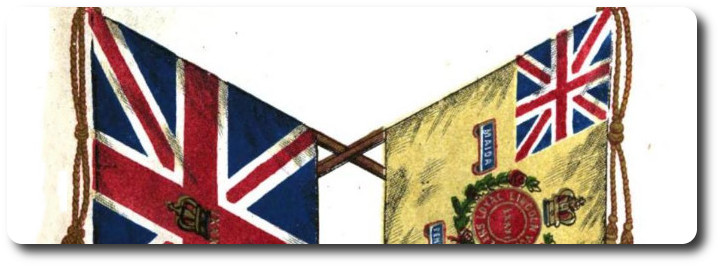Topic: Militaria

Colours of Regiments of Infantry
The Queen's Regulations and Orders for the Army, Horse-Guards, 1st December, 1859
1. The Royal, or first, colour of every regiment is to be the Great Union throughout,—being the Imperial Colour of the United Kingdom of of Great Britain and Ireland, in which the Cross of St. George is conjoined with the Crosses of St. Andrew and St. Patrick, on a blue field,—and is to bear in the centre the Imperial Crown, and the number of the regiment underneath in gold Roman characters.
2. The regimental, or second, colour is to be of the colour of the facing of the regiment, with the Union in the upper canton, except those regiments which are faced with red, white, or black; in those regiments which are faced with red, or white, the second colour is to be the Red Cross of St. George in a White Field, and the Union in the upper canton. In those regiments which are faced with black, the second colour is to be St. George's Cross the Union in the upper canton; the three other cantons black. The number of the regiment is to be embroidered in gold Roman characters in the centre.
3. Those regiments which bear a royal, county, or other title are to have such designation on a red ground round a circle within the Union-wreath of roses, thistles, and shamrocks. The number of the regiment in gold Roman characters in the centre.
4. In those regiments which bear any ancient badge, the badge is to be on a red ground in the centre, and the number of the regiment in gold Roman characters underneath. The Royal, or other title, to be inscribed on a circle within the Union-wreath of roses, thistles, and shamrocks.
5. The regimental, or second, colour is also to bear the devices, distinctions, and mottos, which have been conferred by Royal authority; the whole to be ensigned with the Imperial Crown. Second battalions carry the same colours as first battalions, with the addition of "II BATT." on a scroll below the Union-wreath.
6. The colours are to be of silk; the dimensions to be four feet flying, and three feet six inches deep on the pike, exclusive of the fringe:—the length of the pike (spear and ferrel included) to be nine feet ten inches: the cords and tassels of the whole to be crimson and gold mixed.
7. No addition or alteration is to be made in the colours of any regiment of infantry without Her Majesty's special permission and authority, signified through the Commander-in-Chief of the army.
8. The camp-colours to be eighteen inches square, and of the colour of the facing of the regiment, with the number of the regiment upon them. The poles to be seven feet six inches long.
9. The following table shows the required proportion of camp-colours and pace- sticks for a regiment of infantry, as also the manner in which they are to be provided:—
| Articles | Price. | Length of Time to last. | No. of Articles required. | Out of What Fund to be paid. | Remarks. |
| s. d. | Years | ||||
| Pace Stick | 7 6 | 10 | 17 | 12 by Captains of Companies. 5 out of Postage and Stationery Allowance. | 1 for each Company. 4 for Drill Sergeant and his Aids. 1 for the Sergeant-Major. |
| A Camp-Colour | 5 0 | 5 | 8 | Postage and Stationery Allowance. | The Bunting to be renewed when required. |
| A Saluting-Colour | 5 0 | 5 | 1 | Ditto | |
| Adjutant's Aid | 2 0 | 5 | 4 | Ditto | |
| Time Preceptor and Pendulum | Considered unnecessary, and cannot, therefore, be admitted as a charge against the Fund mentioned,— a Plummet and String being deemed sufficient. | ||||
10. The saluting-colour to be an ordinary camp-colour, to be distinguished only from the other camp-colours by a transverse red cross; when the facings are red, by a transverse blue cross. The flags of battalion aids are to be 33 inches in the pole, including the bunting, which is to be of the same size as that of the camp-colour. The flags are to be carried in the hand, and, when elevated, placed on the muzzle of the fire lock.

